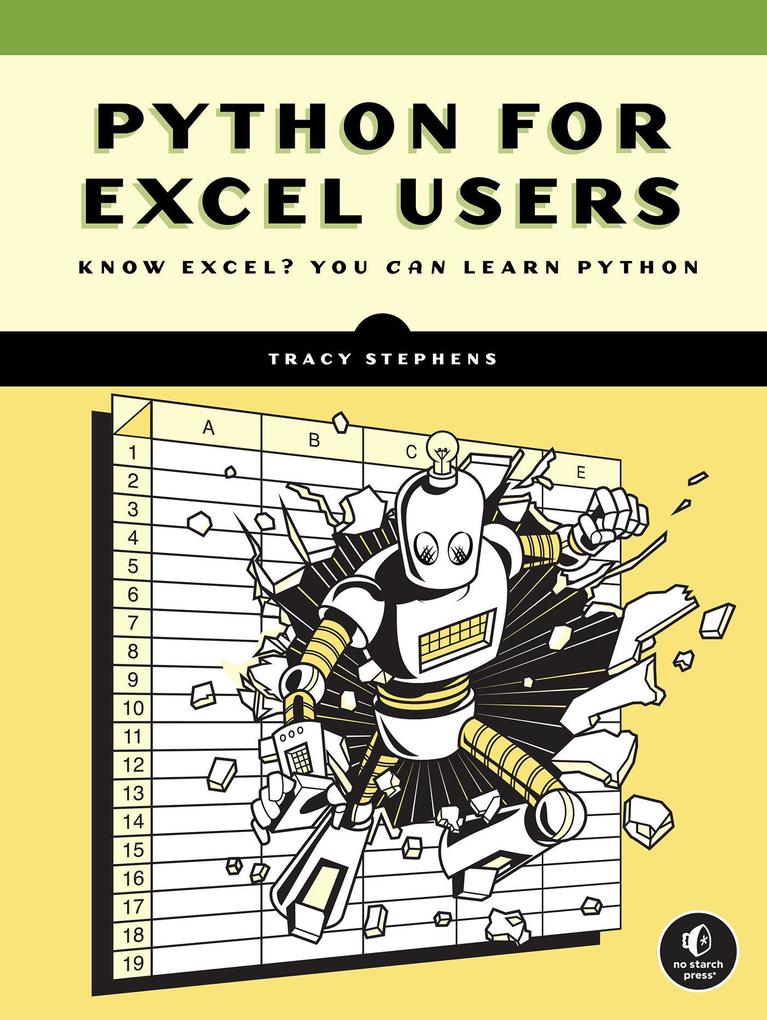
Zustellung: Di, 23.09. - Do, 25.09.
Noch nicht erschienen
VersandkostenfreiWhen Excel isn’ t enough, it’ s time to learn Python.
If you’ re comfortable in Excel, but you’ ve hit a wall— slow files, broken formulas, hours spent on repetitive tasks— this book offers a way forward. It shows you how to take the work you already do in spreadsheets and make it faster, smarter, and more powerful with Python.
You’ ll start by setting up your environment and getting comfortable with Python through short, Excel-inspired exercises. From there, you’ ll gradually move into writing scripts that automate manual work, structure your data, and generate consistent results— no prior programming knowledge required.
You’ ll use your preexisting Excel skills to learn how to:
Throughout the book, you’ ll find practical examples that show why and how to move your work out of spreadsheets and into scripts, and how to resolve issues along the way.
Author Tracy Stephens has extensive practical experience with both Excel and Python. Her approach is grounded in real workflows, and she introduces each concept through tasks you’ ve likely handled in Excel.
This book won’ t ask you to replace everything you do in spreadsheets, but it will help you use Python to work faster, more reliably, and with greater flexibility than you ever could with Excel.
If you’ re comfortable in Excel, but you’ ve hit a wall— slow files, broken formulas, hours spent on repetitive tasks— this book offers a way forward. It shows you how to take the work you already do in spreadsheets and make it faster, smarter, and more powerful with Python.
You’ ll start by setting up your environment and getting comfortable with Python through short, Excel-inspired exercises. From there, you’ ll gradually move into writing scripts that automate manual work, structure your data, and generate consistent results— no prior programming knowledge required.
You’ ll use your preexisting Excel skills to learn how to:
- Translate spreadsheet logic into Python code
- Use pandas to clean, reshape, and filter data
- Automate reports you’ d normally build by hand
- Read and write Excel files directly from Python
- Connect to databases and APIs
- Create professional visualizations with Plotly and Dash
- Organize code into sharable modules and write simple tests
Throughout the book, you’ ll find practical examples that show why and how to move your work out of spreadsheets and into scripts, and how to resolve issues along the way.
Author Tracy Stephens has extensive practical experience with both Excel and Python. Her approach is grounded in real workflows, and she introduces each concept through tasks you’ ve likely handled in Excel.
This book won’ t ask you to replace everything you do in spreadsheets, but it will help you use Python to work faster, more reliably, and with greater flexibility than you ever could with Excel.
Inhaltsverzeichnis
Introduction
PART I: FROM SPREADSHEETS TO CODE
Chapter 1: Python Setup Essentials to Get You Started
Chapter 2: Python Concepts Explained Through Excel
Chapter 3: Creating Automations with Python Scripts
Chapter 4: Keeping Track of Code with Version Control
PART II: DATA ANALYSIS DONE RIGHT
Chapter 5: Interactive Coding for Data Analysis
Chapter 6: Data Manipulation Made Easy
Chapter 7: Storing and Accessing Data with a Database
Chapter 8: Retrieving External Data with APIs
Chapter 9: Visualizing Data with Charts
Chapter 10: Sharing Data with Interactive Reports
PART III: CRAFTING GOOD CODE
Chapter 11: Writing Simple, Scalable Code with Classes
Chapter 12: Debugging and Testing Your Code
Chapter 13: Three Habits for Effective Coding
Afterword
PART I: FROM SPREADSHEETS TO CODE
Chapter 1: Python Setup Essentials to Get You Started
Chapter 2: Python Concepts Explained Through Excel
Chapter 3: Creating Automations with Python Scripts
Chapter 4: Keeping Track of Code with Version Control
PART II: DATA ANALYSIS DONE RIGHT
Chapter 5: Interactive Coding for Data Analysis
Chapter 6: Data Manipulation Made Easy
Chapter 7: Storing and Accessing Data with a Database
Chapter 8: Retrieving External Data with APIs
Chapter 9: Visualizing Data with Charts
Chapter 10: Sharing Data with Interactive Reports
PART III: CRAFTING GOOD CODE
Chapter 11: Writing Simple, Scalable Code with Classes
Chapter 12: Debugging and Testing Your Code
Chapter 13: Three Habits for Effective Coding
Afterword
Produktdetails
Erscheinungsdatum
23. September 2025
Sprache
spanisch
Untertitel
Know Excel? You Can Learn Python.
Sprache: Spanisch.
Seitenanzahl
344
Autor/Autorin
Tracy Stephens
Verlag/Hersteller
Produktart
kartoniert
Gewicht
368 g
ISBN
9781718503984
Entdecken Sie mehr
Bewertungen
0 Bewertungen
Es wurden noch keine Bewertungen abgegeben. Schreiben Sie die erste Bewertung zu "Python for Excel Users" und helfen Sie damit anderen bei der Kaufentscheidung.








